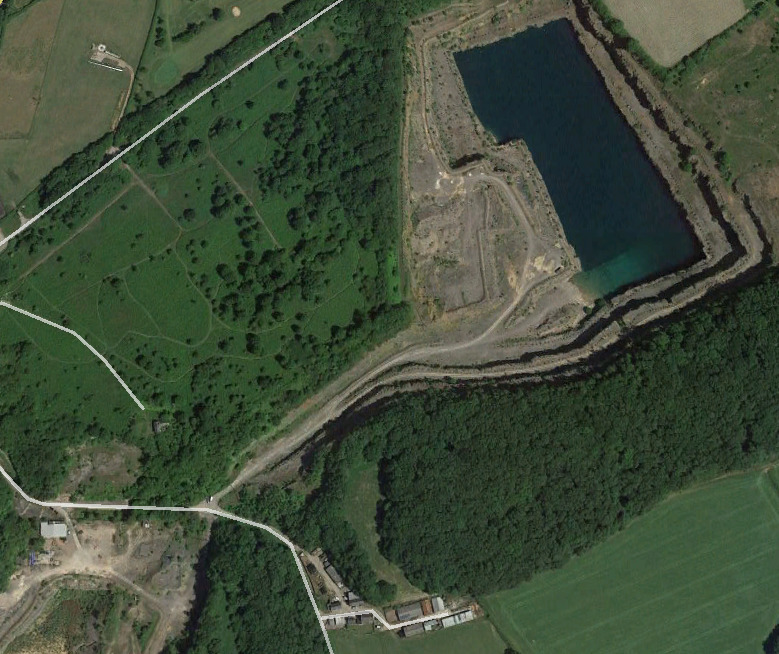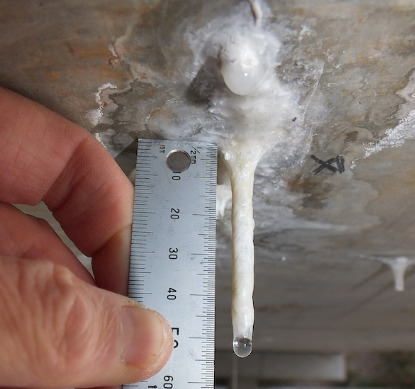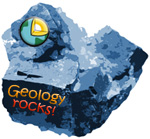The term “stonicle” comes from very similar EarthCaches in London and Scotland
( GC3Y075 & GC4KVKG )
Garwa Quarry is located near Ruthin in the Vale of Glamorgan, it formerly excavated carboniferous limestone.
The coordinates take you to the base of a large brick building on the edge of the site.
Garwa Quarry is now inactive, ending production around 2006.

Mid-Glamorgan continues to be a massive stone and aggregates reserve, although some sites have been closed.
“Stalactites” growing from concrete structures have similarities in the way they develop to equivalent 'speleothems' growing in limestone caves, but there are distinct differences in processes of formation.
Speleothems are stalactites, which are deposits of calcium carbonate that are usually found in limestone caves. They hang downwards like an icicle. They are formed due to water that contains calcium bicarbonate dripping, but the water evaporates, leaving a calcium carbonate deposit.
Calthemite is a secondary deposit, derived from concrete, lime, mortar or other calcareous material outside the cave environment. Calthemites grow on or under, man-made structures and mimic the shapes and forms of cave speleothems, such as stalactites, stalagmites, flowstone etc
The key difference is that the straws growing from concrete can grow hundreds of times faster than straws in caves.
To make concrete, aggregate (limestone chippings) and sand are mixed with cement. When water is added to the mix it reacts readily with the calcium oxide, CaO, in the cement to form calcium hydroxide. Ca(OH)2.
Any carbon dioxide trapped in the mix will readily react with the Ca(OH)2 to precipitate calcium carbonate, CaCO3, within the concrete structure. This overall reaction has been generally termed as “concrete carbonation”
If rain, or seepage water from other sources, (the leachate), penetrates into microscopic cracks, gel pores and air voids in set concrete it will readily carry the Ca(OH)2 in solution to the edge of the concrete. When this leachate comes into contact with air containing CO2 the reaction takes place and precipitates calcium carbonate, to create CALTHEMITE straws

The increase in diameter of the straws is affected partly by the creeping of the lime solution up over the rim of the stalactite.
Studying stalactites growing from a bridge containing concrete, Ver Steeg (1932) found that the growth rates compared closely with those of stalactites growing from concrete in a mine tunnel studied by Allison (1923)
From the same study, Ver Steeg (1932) expected the above ground stalactites to grow more quickly in conditions with lower relative humidity, increased air circulation and higher air temperatures, resulting in more evaporation than is typically experienced underground.
The growth rate of calthemite straws can vary considerably due to a wide range of chemical and physical conditions
The most influential factors are the continuity of leachate solution and drip rate. Evaporation of solution due to atmospheric conditions had no detectable affect on CaCO3 deposition
Apparently straws can achieve an average growth rate of 0.01 of a millimetre per day, (1/100mm), when drips were 11 minutes apart (according to research!)
However too fast a drip rate results in minimal or no growth and too slow a drip rate can cause the straw to calcify over and block up
Most of the concrete work at this site seems to have been completed in the early 1940’s
LOGGING TASKS
Look underneath the building, FROM OUTSIDE THE FENCE, to the right, where you are standing.
Please DO NOT touch the calthemite straws as they are very fragile
1) Estimate the length of the longest "straw"? And how many calthemite straws would you estimate are there?
2) Do you see any drips today? Might they be still growing?
3) Assuming the average growth rate mentioned above, how long do you think the longest one has been growing here?
4) How did the calcium get into the water?
5. DO NOT FORGET TO INCLUDE A NON SPOILER REQUIRED PHOTO OF YOU OR A PERSONAL ITEM,SUCH AS YOUR CACHING NAME.
((Rule Change Updated 10 June, 2019 Geocachers can be asked to provide a photo of themselves or a personal item to prove they visited the site.))
Send the answers to 1-4 in a message / email to the cache owner.
Do not post answers in your log. You are welcome to log the cache before receiving my confirmation email.
If at the coordinates, you want to take a photo of yourself and/or GPS at the location and post this in your log, thats OK.
BUT PLEASE DO NOT POST A PHOTO OF THE ACTUAL CALTHEMITE STRAWS
You should carry out these educational tasks as required by the EarthCaching organization, as a condition of logging the cache. Logs that do not adhere to these guidelines will be deleted without notification. See http://www.geosociety.org/earthcache
WELL DONE to "___FFINITEE & INFFINITEE ___" on a joint 'FTF' !!!

